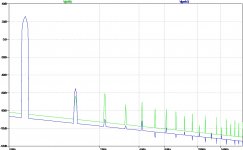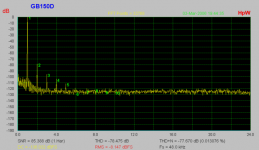The modifications I made to my amps brought the design to 2013 standards IMO. I'm still really happy with them.
Greg added 1 resistor per rail for the source R. The .15 unit. This helps to stabilize the bias. I added a separate resistor to each mosfet. It was a pain to do but it locked the bias right in and works better then a single .15.
Mike, could you please elaborate on how you did it? I'm sure I could do it with no problems, but you may have an idea on implementation I don't think of...
Check Cordell's prediction model.Thanks Andrew, excellent.
Check Cordell's prediction model.Thanks Andrew, excellent.
Don't just accept the first Web statement you see.
Mike, could you please elaborate on how you did it? I'm sure I could do it with no problems, but you may have an idea on implementation I don't think of...
Mike?
Member
Joined 2009
Paid Member
I can say without any issue at all my SKA amp drives ny speaker so far I have thrown at it..
You clearly have too many speakers there - I am willing to find space for a few if this would help
This amp looks very interesting because of all the good sound reports. And the bootstrapped LTP is very similar to what I did on my TGM6 which worked well but was a single ended input design. I will be looking more closely at this SKA amp, especially if there is going to be a pcb designed up.
Last edited:
This design is very interesting but the pcb alone is expensive from the designer web site. I will also probably wait for someone here doing its own pcb at a diy price.
I also wonder if it is preferable to select MOSFET with VGSoff closer to 4v than 2v to allow to be further away from vce saturation of the previous BJT follower....
Fab
I also wonder if it is preferable to select MOSFET with VGSoff closer to 4v than 2v to allow to be further away from vce saturation of the previous BJT follower....
Fab
Last edited:
This design is very interesting but the pcb alone is expensive from the designer web site. I will also probably wait for someone here doing its own pcb at a diy price.
Fab
I'd be interested too!
And if is not asking too much please place the mosfets at the back of the board so it can be attached parallel to heat sink, like PMI VSSA board. Also, it would be interesting to incorporate Mikeg mods.
Mike G mods are already in the current schematic, so if the basis for any boards is that circuit, they'll be up to date.
Some of us purchased Greg's early boards before a number of minor tweaks were made and published over on the SKA forum. Most of these could be adopted easily, but the tweak Mike mentioned above is slightly more involved due to current draw of the Mosfets, I believe.
Some of us purchased Greg's early boards before a number of minor tweaks were made and published over on the SKA forum. Most of these could be adopted easily, but the tweak Mike mentioned above is slightly more involved due to current draw of the Mosfets, I believe.
Member
Joined 2009
Paid Member
it's not set up properly
M2, M4 source should be connected to R22, not drain. Output is <100mV with DC operating point after this is corrected.
Output bias current in R21, R22 is 1.2A, seems high for a 150W RMS amplifier.
thanks, saved me some work

mlloyd1
mlloyd1
I like to see how things work in Spice. I've loaded up the schematic, but it's not set up properly - a starting point for somebody if interested ?
Member
Joined 2009
Paid Member
Corrected version attached. For comparison purposes I have also included my own TGM6 amplifier, which is a single LTP input where I have also bootstrapped the LTP collector load from the VAS (no cap needed in my case) - just for fun. The FFT is quite different of course, the TGM6 (blue trace) being an asymmetric input stage has more H2 distortion, but it's distortion profile for higher orders is much cleaner than the SKA (green trace) - cleaner in fact than any other Class AB amplifier I've ever simulated. The profile for SKA looks like decreasing distortion products - a desirable situation for some people.
Attachments
Last edited:
My own LTSpice and Simetrix simulations keep showing that the SKA is only marginally stable. Ok simulations are not the last word for this, but lack of an output inductor scares me. Too much cable capacitance could cause the blown FETs some report
Greg specifies on the outputs coil of two layers of enamelled copper wire wound onto a resistor where there are stability issues. However, in practice I think few users have reported issues, therefore it was left off standard spec to limit components in the signal path. From memory this is mentioned in the build guide when you buy the kit or boards.
Bigun said:...is much cleaner than the SKA (green trace) - cleaner in fact than any other Class AB amplifier I've ever simulated. The profile for SKA looks like decreasing distortion products - a desirable situation for some people.
Greg says: Of course my development work for this amplifier used real supply impedance not simulation with theoretical 'perfect' supplies...then the distortion changes significantly as PSSR artefacts intrude ...simulation with zero impedance supplies favours amps with poor supply rejection, and offers no real comparison.
Transparency on difficult loads is the prize...
Last edited:
- Home
- Amplifiers
- Solid State
- SKA GB150D now public domain...

